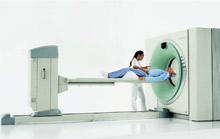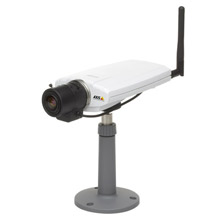Axis Communications' mission
Axis cameras ensure the precise but very unobtrusive monitoring of the resting or sleeping patients
Resting or even sleeping on demand is difficult for most people, in particular if they are still under observation. However, in the case of diagnostic imaging procedures for cancer detection, such as the combined method of positron emission tomography (PET) and computer tomography (CT), patients must be strictly rested and motionless during the examination. To solve this problem, Linz General Hospital uses network cameras that firstly keep an unobtrusive eye on patients and secondly provide medical personnel with immediate notification if patients move excessively, which could affect the accuracy of the diagnosis.
Solution
AKH Linz has already been using network cameras for monitoring its cash dispensers and access areas in the vicinity of its EDP system rooms since 2005. Werner Lenz, CEO of IT service provider Lenz IT & NetWorking Solutions, has been responsible in recent years for the implementation of these camera systems at AKH Linz and is now also in charge of installing network cameras in the relaxation rooms. After his positive experiences with Axis, he again decided in favour of the Axis network video products. Four AXIS 221 Network Cameras, extremely fast day-and-night network cameras, transmit images of resting or sleeping patients to the nurses and doctors in the central control room. They feature a Pentax lens and a CCD image sensor, as well as an automatic, removable infrared-cut filter that permits colour images in relatively good lighting conditions, and black-and- white infrared images in darkness. The cameras must not be swivelled; any blind spots are simply bridged with a new camera. The power supply is fed in via the network cables and is secured using UPS (Uninterruptible Power Supply).
Result
The cameras ensure the precise but very unobtrusive monitoring of the resting or sleeping patients and thus guarantee an extremely reliable diagnosis. Only if the patients rest for at least 50 to 70 minutes in preparation for the procedure can the previously injected or inhaled radio-labelled substance become concentrated in the relevant parts of the body. Via a monitoring screen with various views, the doctors and nurses can keep all patients in view simultaneously and do not need to be physically present in the relaxation room. This is advantageous not only to the hospital personnel, but also, in particular, to the patients themselves, who should feel completely unaware that they are being monitored. If patients become restless, because they feel nauseated for example, the alerted doctors can intervene immediately.
 |
| Axis network cameras transmit images of sleeping patients to the nurses and doctors in the central control room |
AKH Linz has an around-the-clock staff of over 2,200. With around 1,000 beds, more than 53,000 inpatients and 5.5 million outpatient treatments, as well as around 30,000 operations per year, AKH Linz plays a central role in healthcare services in Upper Austria. To fulfil this role, the hospital, which was spun off from the municipal government at the start of 2006 and has since become a 100% subsidiary of the municipal government, continuously invests in modern examination and security methods.
The commissioning of the first PET/CT at the AKH is scheduled for May 2008. PET/CT is a combination of two imaging examination procedures that have proven highly successful in the diagnosis of specific types of cancer. As a nuclear medicine diagnosis procedure, PET detects increased glucose metabolism in specific cells and can thus indicate the presence of a tumour. The CT image acts as an X-ray diagnosis method similar to a precise underlying map. The fusion image of both procedures clearly indicates the tissue area where the increased metabolism is located.

















